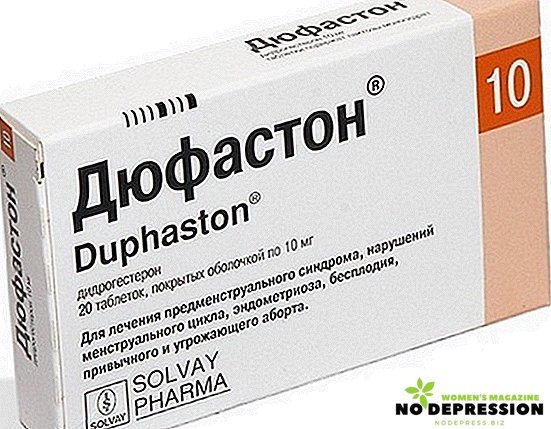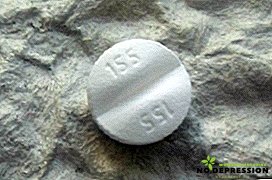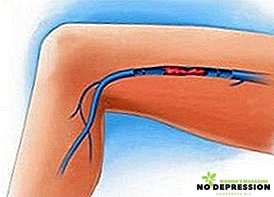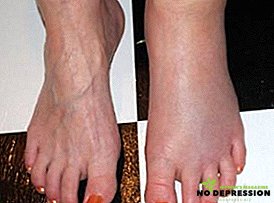Duphaston (dydrogesterone) is a gestagen synthesized in 1950 as a result of ultraviolet irradiation of progesterone.

Its molecule is changed by changing the location of the methyl group:
- in the field of carbon atom With 10;
- and hydrogen in C 9.
An additional compound C 6 with C 7 appeared.
As a result of the transformations, an active metabolite was formed that has selective progestin activity.
Progesterone itself is practically not absorbed from the digestive tract, because it is destroyed in the intestine.
An important property of didrogesterone is its bioavailability. She is 28%. A steady concentration of the drug in the blood is set at 3 days of taking the medicine.
Special features
In the body, 3 metabolites of Duphaston are formed. The main - 20-dihydrodrodrogesterone - has 20 times more progesterone, progestogenic activity. This allows you to significantly reduce the dosage of the drug and reduce the effect of hormones on the liver.
When converting didrogesterone:
- there is no aromatization, so it does not have the effects of estrogen;
- there is no hydroxylation process, as a result there are no androgenic abilities.
Duphaston has a very high selectivity to progesterone receptors. This increases the effectiveness of the drug.
This is especially good for patients who have a reduced sensitivity of these receptors. The high selectivity of the drug (tropism only to progesterone receptors) forms its good safety.

Since didrogesterone does not bind to:
- mineralocorticoid;
- androgenic;
- and glucocorticoid blood receptors.
This causes his lack of a mass of negative manifestations that are present in other therapeutic forms of progesterone.
On the farm. Duphaston first appeared in the market in 1961. It is similar in structure to natural progesterone, but the differences in its structure determine:
- good digestibility when using the drug inside;
- efficiency with this method of admission;
- metabolic stability;
- lack of androgenic, estrogenic and mineralocorticoid properties;

- progesterone receptor selectivity;
- decrease in uterine contractility.
This makes it possible to prescribe it to pregnant women with minimal risk.
When taking Duphaston do not arise:
- peeling of skin areas;
- acne;
- hair loss.
What is prescribed
Duphaston stimulates the secretory maturation of the endometrium (inner lining of the uterus) after a period of its growth under the influence of estrogens. Excessive effect of estrogen in disorders of ovulation (maturation of the ovum) leads to endometrial hyperplasia. And the medicine in this case provides its protection.
In addition to the secretory transformation of the endometrium, Duphaston is a drug that supports pregnancy. He is most important at the beginning:
- progesterone deficiency in the corpus luteum phase can reduce endometrial susceptibility. This is one of the basic causes of egg attachment impairment;
- it relaxes the muscles of the uterus, the increased contractility of which can provoke spontaneous miscarriages;
- protection of progesterone in the early periods of pregnancy is associated with the normalization of the immune response of women.
During physiological pregnancy, progesterone receptors are located on the surface of the mother's lymphocytes, the number of which is gradually increasing. Under the action of progesterone, lymphocytes synthesize a protective protein.

Its formation is reduced by:
- habitual miscarriage;
- threatened miscarriage.
This necessitates the appointment of didrogesterone or its analogues.
The main properties of Duphaston:
- protects the endometrium;
- provides full implantation;
- preserves pregnancy
explain its widespread use by gynecologists.
The medicine is used for:
- hormonal correction;
- test with progesterone;
- treatment of gestagen deficiency;
- treatment and prevention of endometrial hyperplasia, correction of endometriosis, endocrine infertility;
- prevent pregnancy failure.
Due to the good tolerability of Duphaston, its selective action on progesterone receptors, it is used in the treatment of infertility for:
- hormonal correction of the luteal phase;
- preservation of early pregnancy.
Duphaston Application
Many gynecological diseases need to compensate for the lack of internal progesterone.
Secondary amenorrhea
This diagnosis is set if there is no menstruation for at least 6 months, and the pause is not caused by lactation, pregnancy, or physiological menopause.

Oligomenorrhea - the absence of menstruation for more than 50 days. Secondary amenorrhea is not a separate disease, but a symptom.
Its causes may be:
- anatomical features (infections, curettage, scars, obliterating uterus);
- endocrine pathology;
- and iatrogenic effect.
Progesterone test for amenorrhea - the introduction of progesterone or its analogues determines:
- endometrial susceptibility to variations in progesterone levels;
- features of its decline;
- level of synthesis of endogenous estrogen.
To perform a progesterone test, 20 mg of duphaston is administered e / d orally - 10 days.
With secondary amenorrhea with reduced estrogen, Duphaston will cause regular bleeding when used in conjunction with estradiol.
A painful, prolonged or abundant menstrual response indicates changes in the structure of the uterus (polyps, adenomas, fibroids, endometrial hyperplasia).
If the menstrual reaction does not occur, you can think of a pronounced decrease in estrogen production, causing:
- lack of proliferation of the endometrium or the complete absence of the inner layer in the uterus;
- or evidence of fusion of the cervical cavity.
A sufficient amount of estrogen and low progesterone are determined in anovulatory cycles during:
- menopause;
- puberty;
- with polycystic ovaries.
Patients with amenorrhea as a result of insufficient functioning of the corpus luteum and a normal or elevated amount of estrogen have a significant risk of developing uterine cancer and endometrial hyperplasia.
In these patients, prescription of progesterone for 12-14 days. in each cycle it is able to protect the endometrium from the effect of excess estradiol.
DMK - dysfunctional uterine bleeding
These are long, heavy or frequent bleeding due to the absence of established systemic diseases or diseases of the rectum, uterus, bladder, ovaries.
Many women with MQD have a regular menstrual cycle. Bleeding may be accompanied by anovulation. Especially often this condition develops at the end or at the beginning of the reproductive period.
The irregularity of cycles in anovulatory DMK is associated with:
- irregular estrogen synthesis;
- lack of secretory changes in the endometrium due to progesterone deficiency.
Excess estrogen can cause endometrial hyperplasia and bleeding when it is rejected.
In anovulatory cycles, Duphaston's administration prevents heavy bleeding.
Why is Duphaston prescribed before conception
In infertility due to insufficient luteal (progesterone) period, the appointment of Duphaston (progesterone analogue):
- fill its internal deficit;
- prepare the body for the upcoming pregnancy;
- and will help to safely pass its first months.
Using Duphaston to save pregnancy
About 15% of pregnancies, according to statistics, end in miscarriage.
Duphaston is a drug with a proven effect to prevent spontaneous abortions. It is widely used for more than 20 years in honey. practice in the Russian Federation and more than 50 years in the world.
Progesterone analogue - Duphaston - is used for treatment with the threat of miscarriage. Its high performance was confirmed in the treatment of miscarriage, which is considered the most urgent problem of obstetrics.
- It contributes to the preservation of pregnancy.
- It has no negative effect on the pregnant and fetus.

The most common causes of miscarriage:
- infections of the genitourinary system;
- neuro-hormonal disorders;
- action of adverse external causes.
Hormonal ovarian failure accounts for about 39% of cases of spontaneous abortions at the beginning of pregnancy. Therefore, special attention is paid to reducing their functions:
- progesterone deficiency;
- lack of ovulation;
- androgen enhancement.
For treatment, duphaston is prescribed orally at 20 mg / d for 7-10 days. In the future - 10 mg / day. up to 14 weeks of pregnancy.
Drug for the treatment of miscarriage:
- normalizes blood progesterone;
- contributes to the preservation of pregnancy;
- does not cause problems in the fetus and pregnant.
The immunomodulating effect of didrogesterone provides additional assistance for the preservation of pregnancy, since women have, in addition to the hormonal and immunological causes of miscarriage.
When can appoint Duphaston without tests
With clinical, instrumental (ultrasound) manifestations of progesterone deficiency:
- amenorrhea, dysmenorrhea;
- violation of rectal temperature;

- ovulation;
- spontaneous abortions;
- endometrial hyperplasia, etc.
The doctor often prescribes the drug without first determining the level of blood hormone.
In addition, the appointment of progestins is already an analysis (see above - progesterone test).
How to take Duphaston: instructions (approximate diagrams)
- Substitution treatment: in conjunction with the constant appointment of estradiol: 1t - 10 mg / day., E / d last 2 weeks. 28 day cycle;
- Endometriosis: 1 t 2 - 3 r / day continuously or from 5 to 25 days of the cycle;
- Dysmenorrhea: 1 t 2 p / day from 5 to 28 d. Cycle;
- Premenstrual syndrome: 2 p / day for 1 t from 11 - 25 day of the cycle;
- Infertility on the background of progesterone deficiency phase: 1t 1 p / d. from 14 - 25 day cycle. Min Duration - 6 cycles. Reception continues at the beginning of pregnancy for the prevention of abortion;
- The threat of miscarriage: once 40 mg, followed by 10 mg h / h 8 h before the cessation of manifestations;
- Prevention of spontaneous miscarriages: 1 t 2 r / d up to 20 weeks. Pregnancy;
- MQM:
- stop secretions: 10 mg 2 p / day - 5 - 7 days;
- their prevention: 1 t 2 r / d from 11 - 25 day of the cycle.

Contraindications
- Susceptibility to didrogesterone or other components of the drug;
- Suspected or established progestogen-dependent neoplasms;
- Lactose deficiency, galactose intolerance, glucose-galactose malabsorption;
- Undiagnosed vaginal bleeding;
- The use of a combination of estrogen with progestogens, for the prevention of endometrial hyperplasia.
Side effects
Specific
- Breast cancer - the risk arises when taking combined treatment with progesterone and estrogen with 2 g of continuous therapy and grows with continued administration. After 2 to 5 years from the end of therapy, the risk is reduced to the baseline;

- Venous thromboembolism is a terrible complication, the risk of which is greater in the first year of treatment. The occurrence of this complication requires the abolition of the drug and the appointment of antiplatelet agents and anticoagulants;
- Carcinoma and endometrial hyperplasia;
- Hormone-dependent tumors (malignant / benign);
- Heart attack;
- Stroke.
Non-specific side effects
Often occur:
- migraine;
- metrorrhagia.
Seldom:
- hemolytic anemia;

- allergies (dermatitis, angioedema);
- disruption of the liver;
- swelling;
- tenderness or swelling of the mammary glands.
Caution: rules of application
- At the beginning of therapy Duphaston pathological bleeding, it is necessary to find out its cause;
- Assign after the study of the liver. It can not be prescribed for acute, or exacerbation of chronic hepatitis. In case of severe liver failure, this therapy is stopped;
- Carefully observe the patient in the presence of her porphyria, depression;
- After menopause, hormone treatment should be prescribed only if the symptoms of this condition worsen the quality of life. It is necessary to annually evaluate the disadvantages and advantages of such therapy. It continues if the benefits of treatment are higher than the risk to the patient's health;
- Do not appoint when breastfeeding and up to 18 years.
Whether to accept Duphaston or still abstain?
The use of medication according to indications, taking into account possible complications, may be beneficial for a woman’s health.
Additional information about the drug Duphaston is in the next video.
















